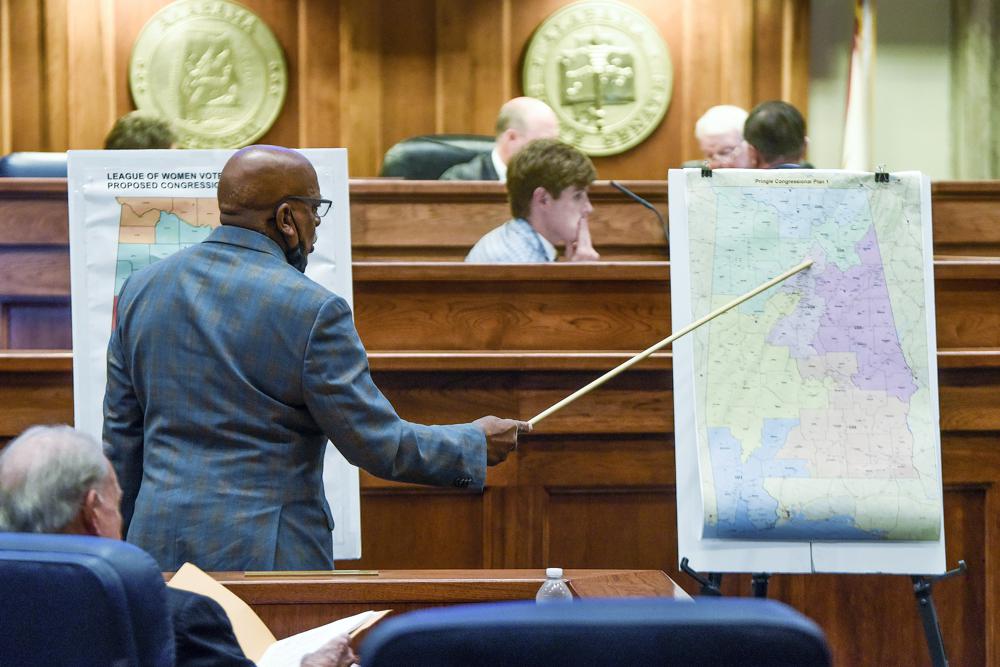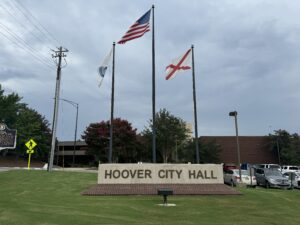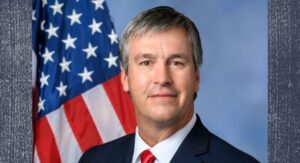Katie Britt: Human trafficking is modern-day slavery, and it’s time to end it

While the spike in violent crime nationwide last year has rightfully grabbed headlines, one heinous crime wave continues to go relatively under the radar. Human trafficking, already the second-largest criminal industry in the world at $32 billion annually, is also the fastest-growing. While this might seem like a distant problem to our state, the reality is that human trafficking is hitting Alabama communities and some of the most vulnerable among us every day. Human trafficking cases have been reported all across our state, from Montgomery and Birmingham to Fort Payne, Huntsville, Albertville, and Guntersville to Dothan and Mobile. The Alabama Human Trafficking Task Force, which brings together public and private sector stakeholders to address the critical issue in the Yellowhammer State, hosted its 8th annual Human Trafficking Summit this past Friday. This is a prime example of the type of awareness and education initiatives that are needed to bring attention, resources, and solutions to the professionals that have the greatest opportunity to help end human trafficking in Alabama, as well as the general public – who can also play a significant role in spotting and reporting signs of human trafficking. As defined by the Trafficking Victims Protection Act of 2000, human trafficking – referred to as Modern Day Slavery – can take the form of both labor trafficking and sex trafficking. Traffickers gain complete control of their victims through coercion, force, or fraud. The statistics behind this barbaric criminal enterprise are difficult to think about yet important to understand. While 80% of human trafficking victims are female, males can certainly be victims, too. Additionally, members of the LGBTQ community are specifically targeted by traffickers. While many adults are victims of trafficking, the average age of entry into sex trafficking is 11-14 years for victims. Of the estimated 27 million slaves globally, approximately half are children. And two children are trafficked into sexual exploitation every single minute. Yes, you read that right. The U.S. Department of Health and Human Services details that the top sex trafficking venues include hotels, motels, truck stops, escort services, and online advertising-based platforms. For labor trafficking, the top venues reportedly include traveling sales crews, restaurant and hospitality services, domestic work, begging rings, and health and beauty services. This is a worldwide scourge, and it’s spreading across Alabama, as well. In fact, the I-20 corridor between Birmingham and Atlanta has the unenviable title of being the “Sex Trafficking Superhighway” and “America’s number one road for human sex trafficking.” While a project by The University of Alabama’s College of Social Work put the number of reported Alabama human trafficking cases to law enforcement and social workers at about 1,200 for 2017, estimates project that the annual number of victims was probably 10 times that across the state. As of 2019, the Global Slavery Index estimated that there are over 6,000 victims of human trafficking on any given day in Alabama. The brazenness and number of online ads by human traffickers in Alabama is even more startling. The College of Social Work at UA reportedly put the number of digital human trafficking ads at 641,000 in 2017 alone in Alabama. A large part of the problem with this growing crisis in the modern age is Big Tech’s unwillingness or inability to crack down on the advertisements. Meta, parent company of Facebook, just last week announced that it has reaffirmed its existing policy of allowing solicitation for human smuggling on its platforms. This effectively allows human traffickers to identify and lure especially susceptible victims. As Alabama’s next Senator, I’ll fight to end human trafficking across Alabama and our nation, and I will always support the victims of this inhumane cruelty. In the Senate, I’ll work tirelessly to ensure our incredible law enforcement and other first responders have the resources and training needed to spot trafficking and address it in their local communities. In addition to awareness and education initiatives, one major step we can and must make on the federal level is to secure our porous southern border, which is enabling and encouraging human traffickers right now. I will also push to strengthen efforts to identify, prevent, and address human trafficking in our supply chains, as well as build capacity to prevent the importation of goods produced with forced labor from places like China. We are grateful for the law enforcement officers, truckers, educators, medical personnel, and other professionals combatting trafficking in our state. And we certainly appreciate the nonprofit workers and volunteers who dedicate their time to fighting this battle. There is a long road to go to ending this conscience-shocking criminal industry. Together, we will protect the most vulnerable Alabamians and make our communities safer and stronger for our children and our children’s children. Katie Britt is a Christian conservative Republican candidate to serve as the next U.S. Senator for Alabama. An Enterprise native, Katie resides in Montgomery with her husband, Wesley, and their two children, Bennett and Ridgeway.
Dan Sutter: Greed and inflation

Inflation topped 7 percent in December, the highest level in forty years. The Biden administration has tried blaming rising prices on corporate greed with antitrust enforcement as a remedy. Does this make economic sense? We must first consider what inflation is. Measured by the rate of change in the Consumer Price Index (CPI), economists define inflation as increasing the general price level. Increases in the prices of some goods with others remaining unchanged raises the CPI but are changes in relative prices. Relative price changes result from changed economic conditions like with lumber in 2020. A “pure” inflation is an equal percentage increase in all prices, including wages and salaries. Inflation also involves an expectation of continued price increases. Pandemic-related production disruptions might cause price increases but not continued increases; prices should stabilize once production resumes and backorders are filled. Is the last year’s CPI increase due to relative price changes or true inflation? We clearly have had some relative price increases for things like lumber and new and used cars (37 percent price increase over the past 12 months). But many CPI components have increased by five or six percent. Most prices are rising. Interest rates provide the best gauge of future inflation. They are based on the decisions of thousands of persons, each investing their own money and superior to any expert’s forecast. Florida Atlantic University economist Will Luther calculates that the bond market currently forecasts 2.6 (2.2) percent annual inflation over the next five (ten) years. Markets expect inflation to moderate but not disappear. Now we can turn to greed and antitrust. I will not distinguish between greed and self-interest here. Economists assume everyone acts in their self-interest. For businesses, this means selling for the highest prices possible, but consumers must voluntarily purchase what businesses want to sell, and competition between sellers limits prices. Greed only explains rising prices if competition has been reduced. State business closure orders during COVID helped bankrupt thousands of small businesses. Yet the impact of these failures on the overall level of competition is likely modest. Furthermore, reduced competition would likely generate a one-time price increase; with less competitive pressure, a business might raise prices by five percent. Since greed is not causing inflation, more aggressive antitrust enforcement will not stop inflation. Economists across the political spectrum recognize this. Larry Summers, former Secretary of the Treasury under President Bill Clinton, said on Twitter: “The emerging claim that antitrust can combat inflation represents ‘science denial.’” Precedent exists for using inflation fears to justify unrelated policies. Until the 1970s, Washington regulated railroads, trucking, and airlines. This was not just safety regulation but control of the number of firms, routes of operation, and prices. Economic research documented the harms of this regulation: higher prices, reduced productivity, and poorer transportation options. The principle of concentrated benefits and dispersed costs from public choice economics explained the persistence of such regulations. The companies and their unions, including the powerful Teamsters, benefited from regulation. Consumers faced an enormous total cost but small individual costs. Regulation was crucial to the industry but a minor issue for consumers. Then something amazing happened. America faced high inflation, and Senator Edward Kennedy sought an issue to boost his presidential hopes. Future Supreme Court Justice Stephen Breyer was on the Senator’s staff and knew about the economic research. Senator Kennedy held widely publicized hearings touting deregulation to offset the pain of inflation. President Jimmy Carter got on board, and by 1980, all these industries were deregulated. Attributing causality is virtually impossible in public policy. But most histories of deregulation cite Senator Kennedy’s hearings as highly important in the process. Deregulation as a cure for inflation is economic silliness. Yet confusion over-inflation may have enabled beneficial policy change. Policymakers, I suspect, remember this lesson. Expect politicians to try selling their pet projects as fighting inflation. But as economist Milton Friedman famously said, “Inflation is everywhere and always a monetary phenomenon.” Alleged inflation remedies should be evaluated on their own merits. Daniel Sutter is the Charles G. Koch Professor of Economics with the Manuel H. Johnson Center for Political Economy at Troy University and host of Econversations on TrojanVision. The opinions expressed in this column are the author’s and do not necessarily reflect the views of Troy University.
Justices weigh Alabama’s bid to stop redistricting order

The U.S. Supreme Court is weighing Alabama’s request to freeze a court order requiring the state to draw new congressional lines and create a second district with a significant number of Black voters. Alabama has asked the court to halt an injunction issued by a three-judge panel blocking the use of the current map after the panel found it likely violates the Voting Rights Act. The Alabama attorney general argued the ruling will throw 2022 elections into chaos and require the state to put race above other redistricting criteria. But lawyers for people and organizations that brought the initial lawsuit dispute that and argue the current lines — similar to those in use since the 1990s — do not reflect a state that has grown more racially diverse. “This is very much a textbook case of a Voting Rights Act violation,” said NAACP Legal Defense Fund senior counsel Deuel Ross, whose organization represented the plaintiffs in the case. The three-judge panel last month found Alabama’s map, drawn by the GOP-dominated Alabama Legislature, likely violates the Voting Rights Act because, “Black voters have less opportunity than other Alabamians to elect candidates of their choice to Congress.” The decision cited Section 2 of the Voting Rights Act which prohibits racial discrimination in election procedures. Alabama’s congressional delegation has for years consisted of one Black representative elected from a heavily Black district and six white representatives elected from heavily white districts. The judges added that any “remedial plan will need to include two districts in which Black voters either comprise a voting-age majority or something quite close to it.” U.S. Census numbers show the state has grown racially more diverse since 1990. Black people make up about 27% of the state’s population while white people make up 63% of the population. “We think that Alabama has an obligation to draw fair maps that are reflective of the state’s very rich history of diversity, not just racial diversity, but diversity in terms of representation for everyone,” Ross said. The Alabama attorney general argues the ruling will improperly require states to prioritize race over other redistricting criteria. “The court-ordered redraw marks a radical change from decades of Alabama’s congressional plans. It will result in a map that can be drawn only by placing race first above race-neutral districting criteria, sorting and splitting voters across the State on the basis of race alone,” Alabama Attorney General Steve Marshall wrote in the state’s appeal to the U.S. Supreme Court. Fourteen conservative-led states signed on to a brief in support of Alabama, arguing that the ruling and “absence of clarity no doubt means litigation will ensue across the country over new maps.” Louisiana Attorney General Jeff Landry filed a brief along with attorneys general from Arizona, Arkansas, Georgia, Indiana, Kentucky, Mississippi, Missouri, Montana, Oklahoma, South Carolina, Texas, Utah, and West Virginia. Lawyers for plaintiffs argued Alabama is misrepresenting the ruling as prioritizing race instead of assessing whether an additional majority-Black district could be created consistent with compactness and traditional districting principles. It is unclear when the court will rule but Alabama faces a looming deadline to get new maps in place unless justices intervene. The three-judge panel pushed back the congressional candidate qualification deadline with political parties from Friday until February 11 to allow the Legislature the opportunity to enact a remedial plan. Alabama lawmakers appear to be waiting on the U.S. Supreme Court’s decision. The legislative reapportionment committee has not met since the ruling of the three-judge panel, some members said. “The attorney general has filed motions of stay and of appeal with the Supreme Court and we’re just going to need to see what the outcomes are, Senate President Pro Tem Greg Reed said. The three judges that issued the unanimous ruling consisted of one judge appointed by former President Bill Clinton — Senior U.S. Circuit Judge Stanley Marcus — and two judges appointed by former President Donald Trump — U.S. District Judge Anna Manasco and U.S. District Judge Terry Moorer. Evan Milligan, a Montgomery resident and the lead plaintiff in the lawsuit, said Alabama likely would have lost a congressional seat if not for the population growth of minority groups, including people born in other countries. “To produce maps that undercount the voting strength of the very population that’s contributing to the ability of the state to even have seven congressional districts is even more indefensible to me,” Milligan said. Republished with the permission of the Associated Press.
Alabama temporarily closing drivers license offices during revamp

The Alabama Law Enforcement Agency plans to temporarily close drivers license offices statewide for more than a week in late April to update a computer system that’s been used for almost 20 years, officials said. A statement from Gov. Kay Ivey’s office said license offices will shut down starting April 18, with plans to reopen on April 26. In addition to new computer hardware, data on file since 1970 will be converted into the new Alabama Law Enforcement Agency Driver License System. While neither in-person nor online services will be available to the public during the transition, a statement said, state examiners will continue to administer road tests for regular and commercial licenses. County offices will be open only for revenue and probate services. Once operating, the new system will let applicants enter information before arriving at an office, officials said. It will also allow users to update personal information through an online system. Fast Enterprises, a Colorado-based technology company, is working on the project for the state. Republished with the permission of the Associated Press.
Black worker at Confederate site raises race complaint

Alabama welcomes visitors at the “First White House of the Confederacy,” a historic home next to the state Capitol where Confederate President Jefferson Davis lived with his family in the early months of the Civil War. The museum managed by the state’s Department of Finance says it hosts nearly 100,000 people a year, many of them school children on field trips to see such things as the “relic room” where Davis’ slippers and pocket watch are preserved. Near the gift shop, a framed article describes Davis as an American patriot who accomplished “one of the most amazing feats in history” by keeping the “north at bay for four long years.” Evelyn England, an African-American woman who worked for 12 years as a receptionist at the historic site, said some visitors, both Black and white, were surprised to see her there. “I’m in a unique position because whites don’t really want me here, and Blacks don’t want to come here,” England told The Associated Press. England, 62, retired this week from the $34,700 state job, and it wasn’t the friendliest of departures: State records show she was suspended for three days last month for refusing to sign a performance review, and she said she filed a racial discrimination complaint with the U.S. Equal Employment Opportunity Commission. A spokeswoman said the Department of Finance declined to comment on the personnel matter. After all those years working among the Davis family’s furniture and belongings, England wishes the museum would take a broader view of history. That slavery was a catalyst for the Civil War “is sort of stated around,” she said. “Tell it like it is. Just tell it like it is. This happened. This is what is known to have happened. Give it as absolute truth as you can….. Until that, you are painting a false narrative that this was a gala — no, there were some ugly things that happened,” she said. Explanatory displays at the museum, where the first Confederate flag still flies outside, mostly discuss the furnishings and how rooms were used, and make little to no mention of slavery, which Davis promoted as “a moral, a social and a political blessing.” The residence was salvaged over a century ago by The White House Association, a state-chartered women’s organization that still owns its contents and remains involved, even as Finance Department employees staff the site. The legislature mandated in a 1923 law that the state-owned building serve as a “reminder for all time of how pure and great were southern statesmen and southern valor.” It would be better, England believes, if the historic site was managed by the Department of Archives and History. The museum’s curator, Bob Wieland, said Friday that he would ask the board to respond to questions about how the museum is run, but he doesn’t think the museum depicts an overly rosy view of Davis. “Jefferson Davis has never been called great in the house. He was the president of the Confederate States of America. We would say no more, no less than that,” Wieland said. England, who would sometimes give tours, said guides only gave information such as the dates (February-May 1861) when Montgomery served as the Confederacy’s capital. The museum has made some changes over the years. She said there once was an area called a “shrine” to Davis. The gift shop stopped selling Confederate flags, except for stickers of the design that was used when the Confederate capital was in Montgomery. “They have taken steps. It might be baby steps,” she said. England, who lives in Marion, said she is a distant cousin of Jimmie Lee Jackson, a civil rights activist shot and killed by a state trooper in 1965. His death helped inspire the voting rights marches from Selma to Montgomery that led to passage of the Voting Rights Act. England was a young child at the time, but still recalls the commotion and pain. In conversations with visitors, England said she would sometimes use questions and humor to try to get them to see a different point of view. When one person maintained that secession was only about preserving states’ rights — a view that had long been taught to southerners as the root cause of the Civil War instead of slavery — she responded, “But did everyone have the same rights?” “You love the Confederacy for what you think it stood for: Your rights,” she would think. “What were they fighting about? Some would say states’ rights. I have a problem with your solution of states’ rights because all individuals in that state didn’t have the same rights.” One day, an older white woman said “Oh, the South will rise!” to no one in particular as she browsed in the gift shop, where the merchandise includes books, stickers of the first Confederate flag, and children’s toys including teddy bears in Confederate and Union uniforms. When the woman turned around to put more items on the counter, England asked her, “What are you rising from?” She said the woman didn’t reply. “If looks could kill I’d be a dead woman,” England said. But many interactions have been positive, she said, recalling good conversations, even with people who — a supervisor warned — could be prejudiced against her. She’s been “chewed out” by some African Americans for working there, she added. “It came at me from both sides,” she said. Many visitors — Black and white — found her race a point of curiosity. “How do you work here?” one white woman asked her. “Ma’am, if you pay every last one of my bills, I’ll quit today,” she jokingly replied. England hopes her presence helped open minds. “Just open up what you are thinking. That’s where the real change is going to occur, in your heart. You can take down monuments. But if what they are still harboring is there, at an inopportune time it will resurface.” Republished with the permission of the Associated Press.


